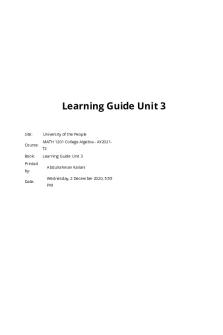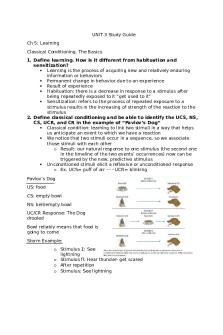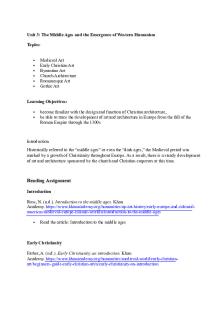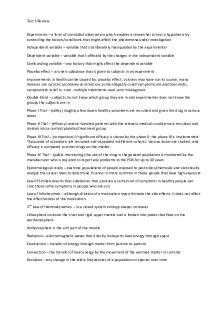Unit 3 Prep Guide - Respondent Behavior (Student)1 PDF

| Title | Unit 3 Prep Guide - Respondent Behavior (Student)1 |
|---|---|
| Author | Ella kerr |
| Course | behaviour analysis and learning psychology |
| Institution | Southern Illinois University Carbondale |
| Pages | 13 |
| File Size | 299.5 KB |
| File Type | |
| Total Downloads | 101 |
| Total Views | 138 |
Summary
prep guide assignment...
Description
Revised 8/2021 EAJ
Unit 3: Respondent Behaviour :Instructions · ·
The first 28 items (pp. 1-4 below) are from Chapter 3 of the Pierce and Cheney textbook. MOST items can be found sequentially in the text. As such, if you read the text with this Prep Guide in front of you, these questions will be almost or entirely complete when you finish reading the chapter. Answers to the final 25 questions (pp. 5-8) are from the “PSYC309 – Unit 3 (Part 1)” and “PSYC309 – Unit 3 (Part 2)” PowerPoints.
Pierce and Cheney Chapter 3 Prep Guide: 1. Behaviour relations that are based on the genetic endowment of an organism are described as __evolutionary ___ and are present on the basis of species history. As such, many survival/reproduction related behaviours are unlearned. 2. What does FAP stand for? Who was the person that studied FAPs with stickleback fish? - Fixed action patterns - Tinbergen 1951 3. What does MAP stand for? What is the key difference between a MAP and a FAP? Hint: MAPs stress something regarding response topography - model action pattern - Considers all behaviour is flexible and adaptable at least to some degree - The key difference is that there are notable variations in behaviour applying some degree of flexibility rather than rigid genetic control 1. What is the key difference between a FAP and a reaction chain? - Reaction chains are similar to FAPs is what was one major difference each set of responses in a reaction she requires an appropriate stimulus to set it off 4. Reaction chains often show behavioural flexibility similar to a _MAP____. 2. Many ___reflexes__ serve defensive, protective, or survival functions. Frequently they are not learned because they have to function before adequate __experience___ is provided. Reflexive behaviour occurs across most or all _____ (two words); therefore, it is important to understand . the laws of the reflex ?Organisms 5. The unconditioned stimuli that ___elicited___ unconditioned responses may vary in intensity. For example, light that is shining in the eye may be bright enough to hurt or so faint that it is difficult to detect. A tap below the knee, causing a kick, may vary from a modest to a heavy blow. The __action/behaviour___ of the eliciting US has direct effects on the elicited reflex.
6. List and define each law of the reflex. People struggle with the differences between these three laws. Make sure you give yourself enough information to distinguish between definitions and examples of each.
Revised 8/2021 EAJ The law of the threshold This law is based on the observation that at very weak intensities a stimulus will not elicit a response but as the intensity of the eliciting stimulus increases there is a point at which the response is elected. Thus there is a point below which no response is elicited and above where a response always occurs The law of intensity-magnitude This law describes the relationship between the intensity of the eliciting stimulus and the size or magnitude of the elicited response. As the intensity of the US increase, so does the magnitude of the .elicited UR. - light tap of the knee, light jump in the leg, harsh tap of the knee, jerk of the leg The law of latency As the intensity of the US increases, the latency to the appearance of the elicited UR decreases.- ex a . strong puff of air to the eye will elicit a quick blink unlike a soft puff will result in a delayed blink
-
7. The example where people would NOT look up after many exposures to volcanic eruptions was used as an example of __habituation___. Make sure you know the definition of this term very well; I would suggest writing it here. one of the more documented secondary secondary properties of the reflex is called HABITUATION, habituation is observed to occur when an unconditioned stimulus repeatedly elicits an unconditioned response and the response gradually declines in magnitude. 8. What are the three major general properties of habituation?
9. Through Darwinian evolution and selection, respondent conditioning became a means of behavioural ___adaptation__. In other words, organisms with a capacity for __respondent or associative__ learning were more likely to survive and reproduce — thereby increasing their genes in the population.
10. Respondent conditioning involves the transfer of the control of behaviour from one __stimulus ___ to another by S–S pairing. Make sure you know what S-S means!!! Respondent conditioning involves the transfer of the control of behaviour from one stimulus to another
11. Imagine that you are out for an early-morning walk and pass a bakery where you smell fresh doughnuts. When this happens, your mouth begins to water, and your stomach starts to growl. These __Conditioned___ responses occur because, in the past, the smell has been paired with food in the mouth (doughnuts). 12. Fig. 3.4: In the bottom half there is an example diagram. Describe this diagram as best you can in your own words. the unconditioned stimulus food The conditioned stimulus is light When the light is turned on, then the stimulus from food occurs Over time ———light——light off——— -
Revised 8/2021 EAJ salivation———-no salivation-———— 13. We hear people say, “The dog salivates when the bell is sounded because it has associated the sound with the food”. BUT THAT MAKES IT APPEAR AS IF THE DOG IS DOING THE ASSOCIATING. Such an explanation is problematic. In contrast, a behaviour analyst points to the physical ___paring__ of stimuli (CS and US) that occurred in the past. In other words, the association is the PAIRING of events—it does not refer to __learned /_active__ associations. 14. The usual measures of behaviour for respondent conditioning are __magnitude __ (amount of salivation) and __latency___ (time to salivation) of response following presentation of the US or CS. Magnitude and latency make sense as behavioural measures because __respondent__ conditioning often involves the actions of smooth muscles and glands or responses that vary on these two dimensions. 15. What does CTA stand for? What does CPP stand for? Why is the sweet substance an NS for CTA and a US for the CPP? CTA - conditioned taste aversion CPP- conditioned place preference A sweet flavoured liquid may function as a CS in taste aversion conditioning and a drug-induced sickness lithium chloride may serve as the unconditioned stimulus after repeated presentations of the flavour followed by the drug into sickness the animal shows avoidance of the sweet flavoured solution in effect known as the condition taste aversion 16. What is “contiguity of stimuli”? What order do you need to present a NS and US? Does contiguity matter when doing respondent conditioning procedures? When stimuli or events occur near in time or are paired together they often become similar in function Well close temporal proximity between conditioned stimulus is an unconditioned stimulus is usually required conditioning of biological sufficient relations between condition stimulus and unconditioned stimulus may be extended in time meaning that there may not be a delay in time such as the sweet tasting liquid inducing sickness as it's a biological reaction 17. Do the Laws of the Reflex apply to learned, conditioned respondents? What generally happens to a CR if you present a stimulus that is similar, but yet a little different from, the CS established through conditioning? - ???
18. What is respondent extinction? How is it related to spontaneous recovery? Note: NEXT chapter we will discus OPERANT extinction. They are different but related. You will be expected to differentiate between them in the future. respondent extinction is the procedure that involves repeatedly presenting the condition stimulus and not presenting the unconditioned stimulus then the results show us decline in stimulation from the subject for example with Pavlov's dogs as the process of responding extinction began the dog salivation decreased over Time as when the metronome sounded and was not paired with the presentation of food the dog .salivation decreased until eventually stopping to the sound of the metronome
Revised 8/2021 EAJ 19. Extinction can be valuable as a ___ therapeutic__ procedure for reducing or removing unwanted __ emotional___ responses such as claustrophobia or arachnophobia. Simply present the CS (the small space or the spider) but do not present the fearful or frightening ___US__ component. The phobic CR will then gradually decrease with repeated trials. Note: There is a LOT more that can be said about this; for now, just understand these basics. 20. A distinction should be made between respondent extinction as a procedure and respondent extinction as a behavioural process. The procedure___ involves presenting the CS but not the US (after conditioning has occurred). As a behavioural ___process__, extinction refers to the decline in the strength of the conditioned response when an extinction procedure is in effect. In both instances, the term extinction is used correctly. 21. Define respondent generalization and respondent discrimination. To understand these concepts well (and to write a good answer) understanding Fig. 3.6 (5th ed.) is very helpful. ·
Respondent Generalization: respondent generalization occurs when an organism shows a condition response to values of the condition stimulus they were not trained during acquisition for example if the amount of hertz presented was 375 the organism would show some response to 450 525 600 675 however in declining values
·
Respondent Discrimination: respondent discrimination is when an organism shows a conditioned response to one value of the stimulus but not to other values this procedure involves presenting both positive and negative conditioning trials for example a positive condition stimulus would be the sound of a bell paired with food whereas a negative condition stimulus would be the sound of a horn which is never paired with food. If this procedure works correctly the animal will no longer salivate to the horn but only to the bell.
·
FREE COMMENTARY: The similarity and differences of the stimuli are NOT judged by our OPINION of whether they are similar or different; they are judged by whether the CR is elicited or not. This allows a cleaner conceptual distinction.
24. I cannot stress the importance of fig. 3.8 (6th ed.) enough. Be able to understand it in extreme detail. I have included it here for convenience. a. What do the little “ups and downs” on the line mean? he ups and downs represent the onset of stimulus is and when they are .her taken away or the reaction stops (imulus on (up); Stimulus off (down b. Label and describe each of the four diagrams (A-D) by noting when the US and NS/CS are presented and removed over time. I will do the first one for you. A. Delayed conditioning: Turn on the NS/CS. Leave it on for a
T eit St
Revised 8/2021 EAJ few seconds. While the NS/CS is on, turn the US on. Wait a few seconds and turn the NS/CS off. Wait a few more seconds and turn the US off. .B
The simultaneous conditioning is where the condition stimulus and unconditioned stimulus represented at the same time for example at the same time does the bell rings food is placed in a dogs mouth Trace the condition stimulus is presented first and then delete over some period of time .C then the unconditioned stimulus is presented and example of this is the condition stimulus being presented for a brief period of time on and off such as a light those flashed and then 20 seconds later food is placed in the dogs mouth the term trace condition and comes from the idea of a memory trace and refers to the fact that organisms must remember the .presentation of the condition stimulus Backward condition and stipulates that the unconditioned stimulus comes on and goes off before the condition stimulus comes on this method is generally unreliable and researchers question whether it occurs at all backwards conditioning as an example would be placing food in the dogs mouth and then ringing a bell however the bell does not then later elicit in .salvation
.D
a. Which one of the four depictions represents the most efficient (and clearly the strongest) method that respondent behavior can be conditioned? Delayed conditioning is the most effective way to condition by delaying the unconditioned stimulus by an increment between five 30 seconds appears to be most effective 25. Define second order conditioning. Include first order conditioning in the definition. What is another term for second (or third, or fourth, etc.) order conditioning? Understand the flower example; think about how this may apply to clinical psychology (including more “complex” disorders). To begin the first-order conditioning is a non-functional event is associated or correlated with an unconditioned stimulus after several conditioning trials the control of the response to the unconditioned stimulus is transferred to the non-functional stimulus which is now called a condition stimulus. And from that we get a second order conditioning which is extending the transfer of control to other events that have not been directly associated with the unconditioned stimulus these events gain control over the response because of the association with an established condition stimulus the second order conditioning involves the presentation of a second condition stimulus along with an already conditioned stimulus one rather than following a condition stimulus with an unconditioned stimulus. And example of this would be someone saying with so many flowers are probably bees a possible interpretation is that the bee is condition stimulus one which is previously stung which is an unconditioned stimulus the person and she has noticed that these hover over flowers which is a condition stimulus to so then the phobia or fear of flowers occurs because of the correlation of bees which is condition stimulus one with the flowers which is .the condition stimulus two 22. What did Siegel et al. (1982) find out regarding the overarching context (i.e., the CS) when taking heroin and the likelihood of overdosing on heroin? In other words, what was their main finding (2-4 sentences)? When heroin is administered in a conditioned stimulus positive environment the amount of heroin that the individual consumes is not lethal to them however when the environment is changed and condition stimulus is are not present than the same amount of heroin can be a lethal dose this is due to
Revised 8/2021 EAJ the fact that when there is a condition stimulus positive environment the condition response is that counteract the drug allow for a larger dose however when the condition stimulus is or not present the opposing conditioned stimulus response does not occur therefore making the drug lethal to the user. In his study he had a control group the same room in a different room and the evidence indicates that the rats that are in a different room were twice as likely to die from the heroin overdose and the rats .in the same room 23. Note the similar effect on immunosuppression and the discussion regarding __placebo___ effects. One thing that these types of studies indicate is that there is much greater two-way interaction between the ___environment__ and —physiological—mechanisms than had been suspected. Organisms are adaptive and they learn. It appears that organs (e.g., salivary glands) and organ systems (e.g., the immune system) can have their functions altered as a result of _experience ____.
24. Carefully read the “Advanced Section: Complex Conditioning” and look at the PowerPoint slides that go along with it.
Here Ends the Pierce and Cheney Chapter 3 Prep Guide. Go to the next page to start the Unit 3 PowerPoint Prep Guide
Revised 8/2021 EAJ Unit 3 PowerPoint Prep Guide --- Start on PowerPoint Unit 3 (Part 1) REVIEW: What are the two basic behavioural relations (i.e., functional behavioural relations)? List the “stimulus and response” abbreviations for these two relations after the name of each relation (i.e., S R or RS). Although this is a review question, the answer can also be found on slide 3 of the Unit 3 (Part 1) PP. 1. REVIEW: _operant__ behaviour is emitted. —respondent —-behaviour is elicited. Again, this is a review question, so use previous material if you get stuck. 2. REVIEW: Conditioned Respondents result from our _____ history. Unconditioned Respondents result from our _Biological____ history. (Hint: The first term starts with an “O” and entails an individual’s life/learning history; The second term starts with a “P” and entails the evolutionary history of an individual’s species). 3. Listen to and read slide 4 (from Unit 3 – Part 1). List the types of respondent behavior discussed in that slide. After each type in an L (to indicate that learning is involved) or U (to indicate the item is unlearned). . Finally, write a short sentence on why the term “reflexes” is in quotation marks Reflexes - U Fixed action patterns - U Reaction chains - U Conditioned respondents - L Elicited behaviours - U 4. A Fixed Action Pattern (FAP) involves a sequence of behavior that (a) is strongly influenced by genetics and (b) is elicited by some specific antecedent(s). What do we call an antecedent stimulus that elicits a FAP? What happens if you remove that antecedent while the behavioral sequence is occurring? Releasers respondent behaviour , use large motor movements, not a twitch or small movement Once started they are completed even of the relaxer is removed 5. What is the key difference between a FAP and a reaction chain? Do not skimp on this answer. However, it can be answered in a short couple of sentences. Spend some time understanding slide 8 (there may be a similar example on the quiz). The difference between a FAP and a reaction chain FAP are elicited by a specific stimuli called releasers they are sequences of behaviour that are phylogenic an origin Also phylogenic in origins reaction changes are sequences of behaviour each response in the chain requires an appropriate eliciting stimulus
-
6. A reflex is not a response. However, a reflex includes a response. What is that response called? What is the shorthand way to diagram a reflex with abbreviations and symbols? What word/term is represented by the arrow? - Unconditioned reflexes - phylogenic in origin as they have biological basis - Unconditioned stimulus elicits an unconditioned response
Revised 8/2021 EAJ - US— UR - Shine light in eyes - pupillary response - Patella knee jerk - Startle response 7. One primary function of reflexes is _____. This function was selected in via phylogenic history. In other words, the term “function” does NOT entail that reflexes have some sort of “teleological purpose”.
((FREE ANSWER due to slide differences between Kail and Dr. Jacobs
Survival
Spend some time on the slides that discuss the core definitional pieces of the “Three Laws of the Reflex”. THEN test your understanding by completing questions 9-11 below. Note: You also listed and defined .these three laws for question 10 in the Pierce and Cheney section above 8. You go to the doctor. She strikes your knee with a rubber hammer to check your patellar reflex (your kneejerk reflex). She keeps tapping your knee at a perfectly consistent strength. Sometimes your leg kicks and sometimes it does not. After 20 taps, your leg kicked 10 times when tapped. What Law of the Reflex does this example likely represent? The law of threshold She keeps tapping your knee, but starts to tap harder and harder. Your leg kicks become stronger and .10 ? stronger. What Law of the Reflex does this example seem to represent The law of intensity/magnitude 9. You notice that when the hammer hits are softer, your leg kicks seem to take longer to occur. When she hits harder, your leg immediately kicks. What Law of the Reflex does this example seem to represent? The law of latency 10. Do the Three Laws of the Reflex apply to conditioned stimuli and conditioned respondents? Note: If you cannot find (or do not know) this answer, then...
Similar Free PDFs

Unit 3 study guide - unit test 3
- 3 Pages

Learning Guide Unit 3
- 20 Pages

UNIT 3 Study Guide
- 19 Pages

Unit 3 Study Guide
- 4 Pages

Postpartum PREP Guide-
- 5 Pages

PREP GUIDE CHAPTER 8
- 2 Pages

Prep Guide 8 Key
- 3 Pages

Unit 3 Study Guide - notes
- 8 Pages

ENGL0101 Learning Guide unit 3
- 12 Pages

Student Study Guide Unit 3
- 13 Pages

Class Prep Assignment #3
- 2 Pages

Note 3 - CFA prep
- 7 Pages
Popular Institutions
- Tinajero National High School - Annex
- Politeknik Caltex Riau
- Yokohama City University
- SGT University
- University of Al-Qadisiyah
- Divine Word College of Vigan
- Techniek College Rotterdam
- Universidade de Santiago
- Universiti Teknologi MARA Cawangan Johor Kampus Pasir Gudang
- Poltekkes Kemenkes Yogyakarta
- Baguio City National High School
- Colegio san marcos
- preparatoria uno
- Centro de Bachillerato Tecnológico Industrial y de Servicios No. 107
- Dalian Maritime University
- Quang Trung Secondary School
- Colegio Tecnológico en Informática
- Corporación Regional de Educación Superior
- Grupo CEDVA
- Dar Al Uloom University
- Centro de Estudios Preuniversitarios de la Universidad Nacional de Ingeniería
- 上智大学
- Aakash International School, Nuna Majara
- San Felipe Neri Catholic School
- Kang Chiao International School - New Taipei City
- Misamis Occidental National High School
- Institución Educativa Escuela Normal Juan Ladrilleros
- Kolehiyo ng Pantukan
- Batanes State College
- Instituto Continental
- Sekolah Menengah Kejuruan Kesehatan Kaltara (Tarakan)
- Colegio de La Inmaculada Concepcion - Cebu



